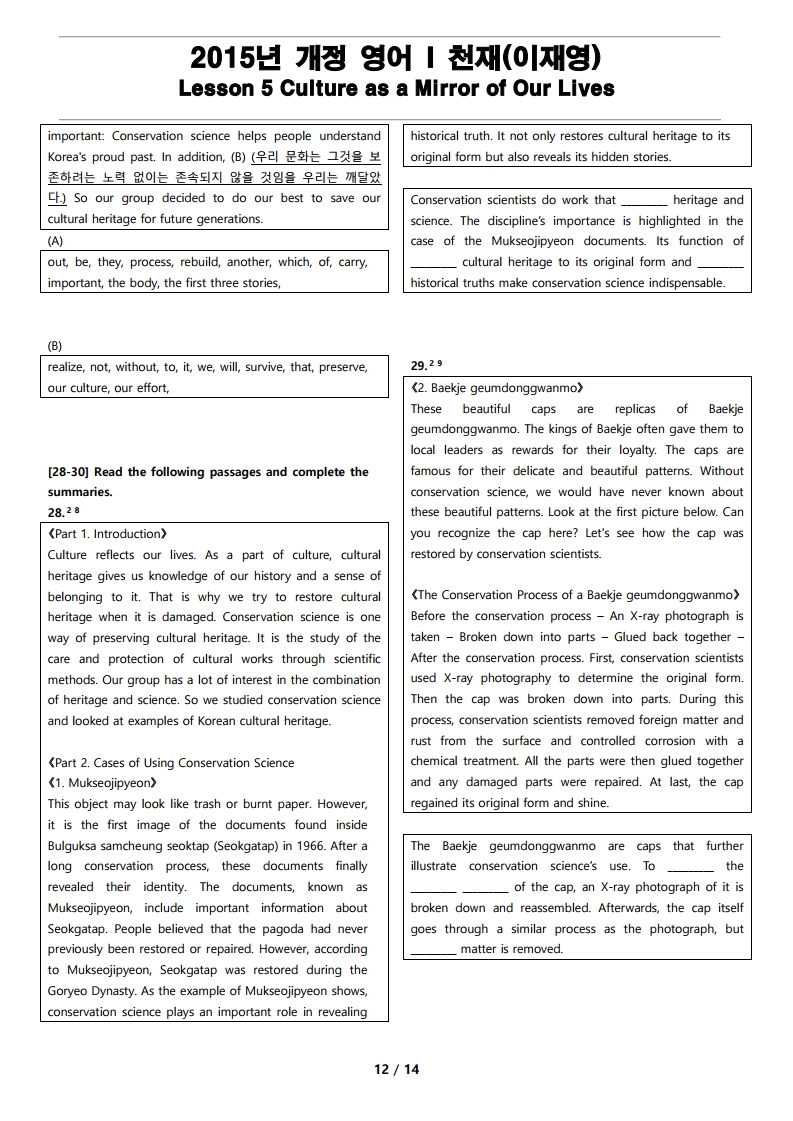2015년 개정 영어 I 천재(이재영)
5과 변형 문제
Culture as a Mirror of Our Lives

일반 워크북 형태의 문제에서 벗어나 The Makings가 만든
2015년 영어 I 천재(이재영) 5과 변형 문제는
출판사에서 오랫동안 영어 번역과 교정을 하셨던 원어민 선생님과
현직에서 강사를 하고 있는 연구진들이 학생들을 위한
최상의 2015년 개정 영어 I 천재(이재영) 5과 변형 문제를 선보입니다.
사고력과 이해력을 요구하는 문제들로 내신 대비 뿐만이 아니라
수능도 한꺼번에 공부하실 수 있는 자료입니다.
중간고사&기말고사 전에 더메이킹스(The Makings)에서
제작한 2015년 개정 영어 I 천재(이재영) 5과 변형 문제로 마무리 하세요.
정답 확인하러가기!
https://themakings.co.kr/49/?idx=611
themakings.co.kr

The Makings의 2015년 개정 영어 I 천재(이재영) 5과 변형 문제는
총 10개의 유형으로 구성되어 있습니다.
1. 빈칸 채우기(객관식)
2. 글의 내용 일치/불일치(객관식/한글 선택지)
3. 글의 내용 일치/불일치(객관식/영어 선택지)
4. 글 끼어 넣기(객관식)
5. 어법(서술형)
6. 어휘(서술형)
7. 주제문(객관식/영어 선택지)
8. 어휘 빈칸 채우기(서술형)
9. 영작(서술형)
10. 요약문 완성하기(서술형)
더메이킹스(The Makings)가 제작한 2015년 영어 I 천재(이재영) 5과 변형 문제의 지문입니다.
1번 지문
《Part 1. Introduction》
Culture reflects our lives. As a part of culture, cultural heritage gives us knowledge of our history and a sense of belonging to it. That is why we try to restore cultural heritage when it is damaged. Conservation science is one way of preserving cultural heritage. It is the study of the care and protection of cultural works through scientific methods. Our group has a lot of interest in the combination of heritage and science. So we studied conservation science and looked at examples of Korean cultural heritage.
《Part 2. Cases of Using Conservation Science
《1. Mukseojipyeon》
This object may look like trash or burnt paper. However, it is the first image of the documents found inside Bulguksa samcheung seoktap (Seokgatap) in 1966. After a long conservation process, these documents finally revealed their identity. The documents, known as Mukseojipyeon, include important information about Seokgatap. People believed that the pagoda had never previously been restored or repaired. However, according to Mukseojipyeon, Seokgatap was restored during the Goryeo Dynasty. As the example of Mukseojipyeon shows, conservation science plays an important role in revealing historical truth. It not only restores cultural heritage to its original form but also reveals its hidden stories.
2번 지문
《2. Baekje geumdonggwanmo》
These beautiful caps are replicas of Baekje geumdonggwanmo. The kings of Baekje often gave them to local leaders as rewards for their loyalty. The caps are famous for their delicate and beautiful patterns. Without conservation science, we would have never known about these beautiful patterns. Look at the first picture below. Can you recognize the cap here? Let's see how the cap was restored by conservation scientists.
《The Conservation Process of a Baekje geumdonggwanmo》
Before the conservation process – An X-ray photograph is taken – Broken down into parts – Glued back together – After the conservation process. First, conservation scientists used X-ray photography to determine the original form. Then the cap was broken down into parts. During this process, conservation scientists removed foreign matter and rust from the surface and controlled corrosion with a chemical treatment. All the parts were then glued together and any damaged parts were repaired. At last, the cap regained its original form and shine.
3번 지문
《3. Gyeongcheonsa sipcheung seoktap》
Gyeongcheonsa sipcheung seoktap is well-known for its elaborate decorations, splendid shape, and unique structure. The pagoda was originally built in 1348 during the Goryeo Dynasty, but it was disassembled and illegally transported to Japan by a Japanese court official. After it was returned to Korea in 1918, it was left disassembled for forty years at Gyeongbokgung Palace. Conservation skills at that time were not good enough to restore it. Although the pagoda was first restored in 1960, it suffered from wind, rain, and so on as time went by. So the pagoda was repaired again and moved inside the National Museum of Korea in 2005. It took almost ten years, from 1995 to 2005, to re-restore the pagoda. Conservation scientists removed the cement used in the first restoration process. They replaced it with marble, which is the same material as the original stone. They also restored some of the original decorations. They carried out another important process, which was rebuilding the first three stories of the body. During the conservation process, scientists found that the first three stories had been put together incorrectly, so they put them back in the right order.
《Part 3 Conclusion》
While working on the project, we found something important: Conservation science helps people understand Korea's proud past. In addition, we realized that our culture will not survive without our effort to preserve it. So our group decided to do our best to save our cultural heritage for future generations.
'2015년 개정 영어 I > 영어 I 천재(이재영)' 카테고리의 다른 글
| 2015년 개정 영어 I 천재(이재영)3과 변형 문제 Toward a Better Environmnet (0) | 2023.03.09 |
|---|---|
| 2015년 개정 영어 I 천재(이재영)1과 변형 문제My Journey, My Life (0) | 2022.03.16 |
| 2015년 개정 영어 I 천재(이재영)2과 변형 문제 Art Around Us (0) | 2022.03.12 |